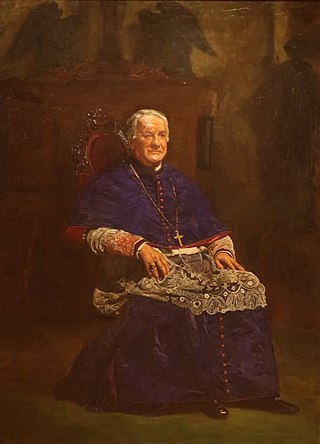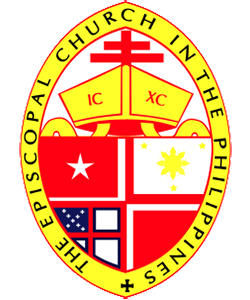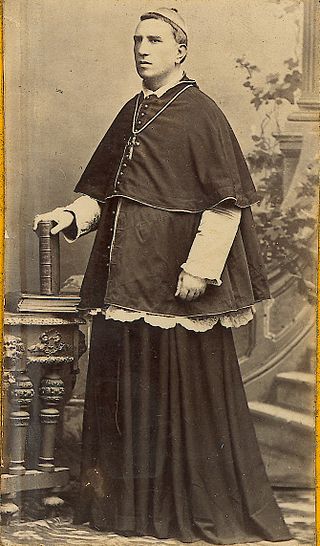
James Frederick Bryan Wood was an American prelate of the Roman Catholic Church. He was the fifth Bishop and first Archbishop of Philadelphia, serving between 1860 and his death in 1883.

Dennis Joseph Dougherty was an American prelate of the Catholic Church. He served as Archbishop of Philadelphia from 1918 until his death in 1951, and was made a cardinal in 1921. He was Philadelphia's longest-serving archbishop and its first cardinal.

Vincent Ferrer, OP was a Valencian Dominican friar and preacher, who gained acclaim as a missionary and a logician. He is honored as a saint of the Catholic Church and other churches of Catholic traditions.

The Archdiocese of Jaro is a Latin Church archdiocese of the Catholic Church headquartered in Jaro, Iloilo City, Philippines. Its episcopal see is at the Metropolitan Cathedral of St. Elizabeth of Hungary, also the National Shrine of Our Lady of Candles, as its seat. The metropolitan archdiocese covers the provinces of Iloilo and Guimaras, an island off Iloilo. Its titular patron saint is Elizabeth of Hungary, whose feast is celebrated on November 17.

Gabriel Martelino Reyes was the 28th archbishop of Manila, and the first native Filipino to hold that post. He previously served as Archbishop of Cebu from 1934 to 1949, and then served as Archbishop of Manila from 1949 till his death in 1952.

James Schwebach was a Luxembourgian-born prelate of the Roman Catholic Church who served as Bishop of the Diocese of La Crosse in Wisconsin from 1892 until his death in 1921.

Stephen Vincent Ryan, C.M. was a Canadian-born American prelate of the Catholic Church. A member of the Congregation of the Mission, he served as Bishop of Buffalo from 1868 until his death in 1896.

The Seminario de San Vicente Ferrer, also known as San Vicente Ferrer, Seminario or Saint Vincent, is a college-seminary of the Roman Catholic Archdiocese of Jaro located in Iloilo City. It was founded in 1869 and is the first institution of higher education in the Western Visayas. It is the fifth oldest and the last seminary that was established during the Spanish colonial period in the Philippines. The Seminarians serve the nearby Jaro Cathedral which houses the miraculous statue of Nuestra Señora de la Candelaria de Jaro, the official roman catholic patron of Western Visayas.

The Episcopal Church in the Philippines is a province of the Anglican Communion comprising the country of the Philippines. It was established by the Episcopal Church of the United States in 1901 by American missionaries led by Charles Henry Brent, who served as the first resident bishop, when the Philippines was opened to Protestant American missionaries. It became an autonomous province of the Anglican Communion on May 1, 1990.

The Roman Catholic Archdiocese of Cagayan de Oro is an archdiocese of the Catholic Church in the Philippines.

José Serofia Palma O.P. is a Filipino prelate and a professed member of the Dominican Order who is currently serving as the Archbishop of Cebu since 15 October 2010. He had previously served as Archbishop of Palo in Leyte. He also served as president of the Catholic Bishops' Conference of the Philippines from 2011 to 2013.

The Diocese of Bacolod is a Latin Church ecclesiastical territory or diocese of the Roman Catholic Church in Negros Occidental, Philippines. A suffragan of the Archdiocese of Jaro, its jurisdiction covers most of the northwestern towns and cities of the province of Negros Occidental namely, as far as Victorias City in the north and the Municipality of Hinigaran in the south.

The Metropolitan Cathedral of Saint Elizabeth of Hungary, also known as the National Shrine of Our Lady of the Candles and colloquially as Jaro Cathedral, is a cathedral located in the district of Jaro in Iloilo City, on the island of Panay in the Philippines. The seat of the Roman Catholic Archdiocese of Jaro, it was placed under the patronage of Saint Elizabeth of Hungary. It was established in 1575 as a visita (chapel-of-ease) of Oton by the Augustinians and as a separate parish in 1587. The present-day structure of Jaro Cathedral was built in 1874.

Fernando Robles Capalla is a Roman Catholic archbishop-emeritus of the Archdiocese of Davao. He was born on November 1, 1934 in Leon, Iloilo Province. He was succeeded by Romulo Valles as archbishop of Davao on February 11, 2012.

Alberto Jover Piamonte, D.D., JCD., was the fourth Roman Catholic Archbishop of Jaro in the Philippines. He was born in Iloilo City on 21 November 1934 and was a native of the District of Jaro, Iloilo City. After studying Philosophy and Theology at St. Vincent Ferrer Seminary, he was ordained a priest of the Archdiocese of Jaro on 22 March 1958.
Edward Gerard Hettinger was a bishop of the Catholic Church in the United States. He served as auxiliary bishop of the Diocese of Columbus from 1942 to 1977.

Bishop Andrés Ferrero y Malo de San José, O.A.R., was an Augustinian Recollect, who became the third Bishop of Jaro, from 24 March 1898 to 27 October 1903. He was born in Arnedo, La Rioja, Spain, on 30 November 1846.

Jose Romeo Orquejo Lazo is a Filipino Catholic clergyman who is the thirteenth ordinary of the Archdiocese of Jaro, and the sixth to have the title of archbishop. He was born on January 23, 1949, in San Jose de Buenavista, Antique to Juan P. Lazo and Fausta Orquejo, both now deceased, and was baptized on February 13 of the same year at the St. Joseph Parish of the same town.

Nuestra Señora de la Purificación y la Candelaria is a venerated image of the Blessed Virgin Mary enshrined in Jaro Cathedral and the patroness of Western Visayas.

Bishop Leandro Arrúe Agudo, O.A.R., was the second Bishop of Jaro. He was born in Calatayud, Zaragoza, Spain, on 13 January 1837. He took vows as a professed religious in 1856, in Monteagudo, Navarre, as Fray Leandro Arrué de San Nicolás de Tolentino, in 1865.





















